Cena Y Ciencias Exposes Hispanic Elementary School Students to Materials Science at MRL
April 29, 2019
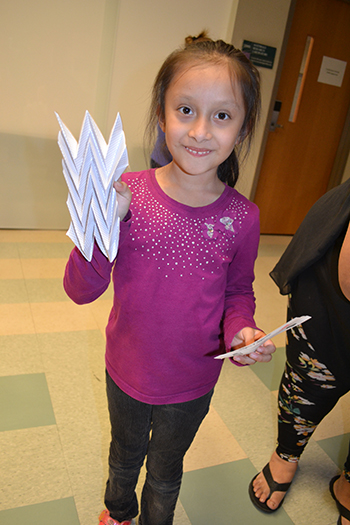
A young visitor exhibits the model she made of graphene for flexible electronics.
As part of I-MRSEC’s outreach through Cena y Ciencias (Spanish for “Supper and Science”), a group of mostly Hispanic K–5 students and their families followed a supper of free pizza at Urbana’s Dr. Preston Williams Elementary School with a visit to the Materials Research Lab (MRL) for the second and equally-as-fun part of the evening—some science. During the April 1st event, the visitors not only participated in a variety of materials-related, hands-on activities, but they also got to interact with Illinois students and staff. Also, since many of those presenting were Hispanic and were leading the activities in Spanish, the youngsters also got to see scientists who look like them and who speak their language.
In addition to I-MRSEC (the Illinois Materials Research Science and Engineering Center), Cena y Ciencias is supported by several other partners, including SACNAS (the Illinois chapter of the Society of the Advancement of Chicanos and Native American Scientists); the National Science Foundation, which has been a source of support for the program since its inception; and Urbana School District employees and parents.
The goal of the evening, in addition to exposing the youngsters to some cutting-edge science, was for kids to discover that science is also fun. Presented by scientists from both the Center for the Physics of Living Cells (CPLC) as well as the Beckman Theoretical and Computational Biophysics group, the exhibit gave visitors the opportunity to not only learn a bit about the researchers' work, which involves computation plus simulations of macromolecules and biological systems, but visitors also got to play with virtual reality (VR).
Regarding the exhibit, CPLC director, Sharlene Denos, shares: "CPLC strives to develop realistic and predictive models of cells and cellular processes," then adds that because their scientists work closely with theorists and experimentalists in a variety of fields, they must be able to explain their work to any audience. Thus presenting at the event benefitted the CPLC researchers as well.
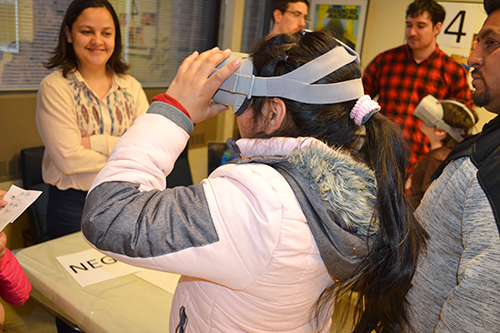
Angela Barragan (left) watches as a young visitor to her exhibit learns a bit about biological systems using VR.
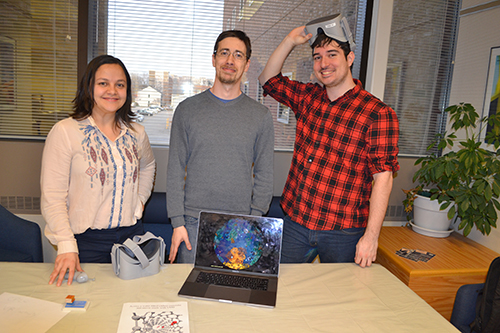
Angela Barragan (left), and two fellow researchers use virtual reality to expose visitors to their research.
"The Cena y Ciencias event was great practice for them," adds Denos, "as they not only had to explain their science to children, but also in Spanish! Though the volunteers were all native speakers, their scientific training has been entirely in English, and it was very challenging for them to present their work in Spanish."
The exhibit provided a VR look at some biological systems. For instance, visitors got to look at water molecules in a water channel inside a carbon nanotube, and were actually getting to see protons jumping from one water molecule to another. Visitors also got to see a VR demonstration of photosynthetic bacteria, called purple bacteria, which basically behave the same as a plant. One member of the group, Angela Barragan, explains why they’re called purple bacteria: “They’re purple!” she exclaims. “So when you see it in a pond and you see the pond is actually purple, and you know that these bacteria are there. These are just purple bacteria, but then the good thing is that they actually perform photosynthesis, as opposed to other bacteria."
So besides the fun of virtual reality, why is it good to expose kids at this age to this research? “This is incredibly useful for them to understand how these things function,” Barragan explains, “how a bacteria functions, and how a bacteria, for example, harvests light and converts that to energy, the energy of the bacteria. That's one of the amazing things that we can do with these VR sets.” And she adds that kids aren’t the only ones who enjoy using VR. “As scientists, we actually sit there and look at them and understand the processes by looking at these. We actually need these types of things to do research."
Another researcher presenting at the event was Sandra Aris, whose bio-inspired designs involve creating antimicrobial interfaces in hydrogel. “Basically the strategy that I use is inspired by nature,” she explains. “For example, I take inspiration from the dragonfly queens to design the topographies of surfaces that can kill bacteria by contact.” At her exhibit, she presented a demonstration with fluorides and bacteria, the hydrogel she produces, and images of a bacteria square.
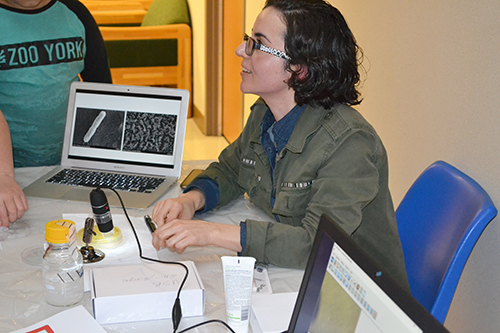
Sandra Aris ineracts with youth visiting her exhibit.
Aris shares why it’s good for kids to come to an event like this, especially one that’s done in Spanish. “I guess it's because they can see role models for them, for the future, or get inspired by us,” she explains. “So I guess it's a good thing for them."
Hispanic MRL Senior Research Scientist Julio Soares also believes it’s special to have Hispanic kids attend an event that's conducted in Spanish. “I like the initiative a lot,” he admits, referring to Cena Y Ciencias. “I think that it's very important. This is an international city, an international town, and I think this is the expression of that. So, it makes the kids feel accepted as well in their community. So I really think that's very important."
Soares demonstrated to the young visitors about contact angles, “so how the surfaces will behave,” he explains, “or how the water will behave on top of surfaces that are hydrophobic (repel or fail to mix with water) or hydrophilic [mix with, dissolve in, or are wetted by water].”
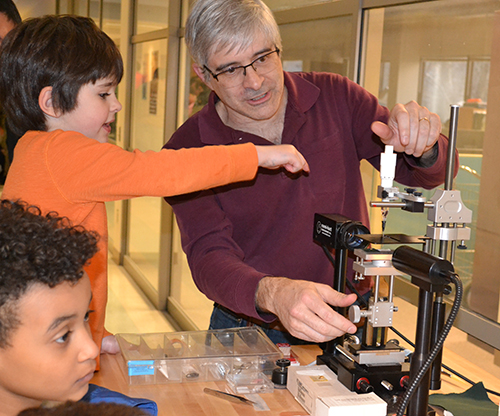
Above: A young Cena y Ciencias visitor watches as Julio Soares (right) does an experiment with hydrophobic or hydrophilic surfaces.
Below: The youngster examines a material sample.
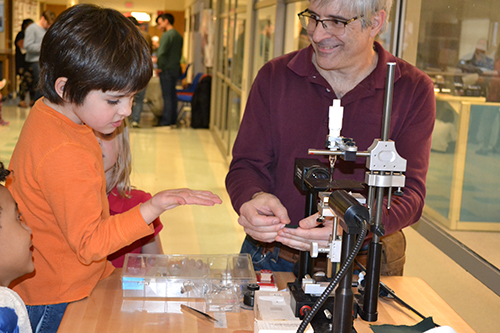
For example, he showed the kids how soapy water spreads more than normal water. Why does soapy water spread differently? Soap makes things have a lower surface tension, so they can be spread around more. “For example, in your hands,” he explains, “it goes on the pores and everything, so that you make sure it cleans it better. So that's why; it wants to decrease the surface tension of the water, so that it spreads more easily throughout surfaces."
He also demonstrated that on hydrophobic cotton, the angle of the droplets is very high because it's a hydrophobic surface, whereas normal cotton just sucks the water down.
He also put a little droplet on the back of a bug so the kids could see that the bug has a hydrophobic surface, which he claims is, “useful for their survival." For instance, when they’re flying around in the rain, they don’t get waterlogged.
Soares shares why bringing younger kids to an event like this is important. "Well, they start getting an interest in science early on, right? And not only any topic in specific, but the curiosity of how things work in the first place. And this is what science is. And that's why I think it's important to bring kids, to ask around about the world that they live in."
Kaustubh Panse and his colleagues at the Wearable Electronics exhibit were excited to expose the kids to graphene and flexible electronics. For example, he thinks graphene has a lot of potential because it's strong yet flexible. “I think, yeah, flexible electronics and graphene go really well hand-in-hand. I think that could be the new big thing of graphene."
Panse was really excited to expose the young visitors to graphene’s amazing properties. "So it's just really fascinating what you can do with materials, right? I mean, a few decades ago, who would have imagined that we'll have these one-atom-layer-thick materials that can actually be used for real applications. And then now we're looking at all these flexible electronic applications. And the thing with graphene is, the interest just doesn’t die down!” He reports that at a convention last year, people made superconductors out of bi-layered graphenes. “Graphene is just phenomenal in terms of properties,” he explains, “and I think this is one thing that the kids can really learn from."
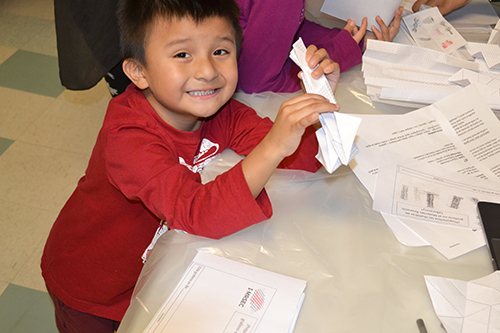
A young visitor folds a paper model of how graphene is folded to use in flexible electronics.
Regarding using graphene as a superconductor, Panse explains, “So if you take bi-layer graphene, and then if you twist it at just the right angle, it can behave as a superconductor." So does he think computers and phones will eventually use graphene? He qualifies that while it is difficult to predict whether it will be pure graphene or graphene in some other form, he definitely expects graphene to be used in future electronic devices.
Young visitors also got to explore vacuum science at the AVS (American Vacuum Society) Student Chapter's exhibit: a home-built vacuum display system that they bring to outreach events to teach K-12 and the general public about vacuum science. On hand to share their excitement about vacuums were AVS student chapter President Shannon Murray and treasurer Sarith Bandara, who placed everyday objects, such as marshmallow peeps, the beloved Easter candy, into a vacuum to see what happens (Peeps in Spaaaaaace!). Visitors also got to see the effect the vacuum chamber had on balloons and shaving cream.
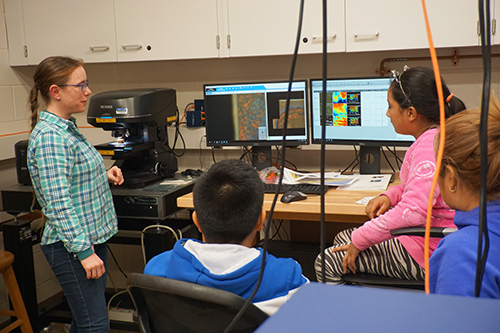
MRL research scientist Kathy Walsh (left), introduces Dr. Preston Williams Elementary School students to the 3D Optical Profiler. (Image courtesy of Pamela Pena Martin.)
MRL research scientist Kathy Walsh also exposed several groups of students to the 3D Optical Profiler, which uses light to study the "profile" or what the surface of something looks like up close. During her activity, students got to take an up-close look and to measure the scale of some familiar objects: strawberries, fabric, coins, and even a bug.
Since I-MRSEC is all about materials, it also makes sense that Brett Kaufman, an archaeologist with the Department of the Classics at Illinois, was also presenting during the event. His exhibit was about materials too—but ancient ones. Some were archaeological materials from excavations in North America, China, and North Africa; other pieces were from modern descendant groups, like the Pueblo culture of New Mexico and Arizona.

Archaeologist Brett Kaufman shares about his work with ancient materials.
Through these ancient materials, Kaufman hoped to show the kids that technology has been around for a long time. “Humans are tool users,” he explains. “The first homo sapien that was born was already using tools because our ancestors before homo sapiens were using tools. And so what we have is basically these technological traditions passed down.”
One artifact Kaufman displayed was a 700-year-old vessel. “You can see that it's the same technique used generation after generation,” he says, then explains that sometimes things changed slowly over time, such as new colors like blue being adopted. “Technology is about both the inherited and learned tradition, but it's also about changing it, and you kind of have new designs as you go."
He shares two reasons why it’s good for kids to learn about ancient materials: “One, it's important to know that humans have a very ancient past, and we share a lot of things. We have a shared past. People are very similar; they are more similar than they are different.”
To illustrate, he showed a 4,000-year-old children's toy—a ball. “Kids in ancient China from 4,000 years ago were playing with little toys just like kids are today,” he says. “There's a common human tradition that we have.”
The other thing he hoped to convey was that he uses scientific techniques from materials science and engineering to study these artifacts. “So just to show kids that science can be used for all kinds of different things,” he adds. “It can be used to build bridges and to build airplanes and cars and to build medical solutions, but also we use it to study the past in sort of an objective way."
So since he uses science, does he consider archeology to be a STEM field? “Archaeology is like the exact middle ground between the humanities and the sciences,” he explains, “because we are studying stuff and things, right? But we are studying them in order to learn about social issues, about social processes, about culture. We're not studying them to develop new materials.” Kaufman considers himself to be a consumer of materials science and other scientific fields. “But what we're doing is producing knowledge about culture, as opposed to knowledge about other STEM fields."
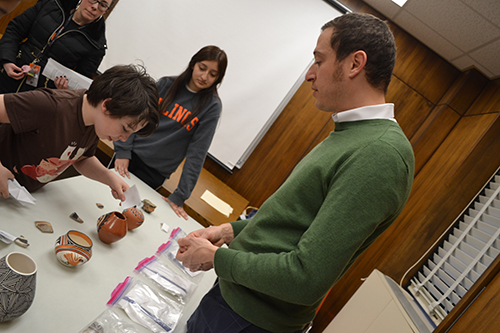
Brett Kaufman (right) discusses his artifacts with a young visitor.
He also shares that design is a big part of what he does with archaeology. “Because design is both the exact engineering specifications and the protocols, but it's also the social things behind it.” He’s referring to questions like, what color it is, what shape it should be, what people want to use, what is the taboo that people don't want to use? “So design is a really interactive process that uses both STEM and humanities processes."
Story and photos by Elizabeth Innes, Communications Specialist, I-STEM Education Initiative
More: Cena y Ciencias, I-MRSEC, K-6 Outreach, SACNAS, Undeserved Minorities, 2020
For other I-STEM articles about Cena y Ciencias, see:
- Cena Y Ciencias Exposes Hispanic Elementary School Students to Materials Science at MRL
- Polímeros! Cena y Ciencias Program Teaches About Materials Through a Supper & Science Night
- Leal Science Night Exposes Local Youngsters to STEM, Role Models
- Cena Y Ciencias: Supper and Science…and Role Models, Courtesy of SACNAS
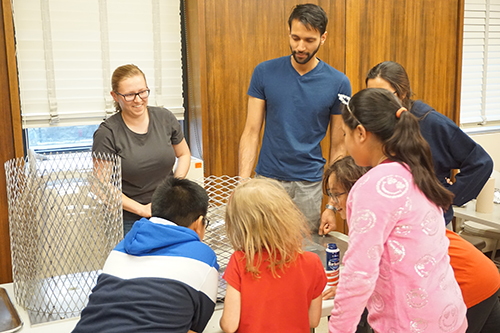 Members of the Illinois chapter of AVS introduce young visitors to vacuum science. (Image courtesy of Pamela Pena Martin.)
Members of the Illinois chapter of AVS introduce young visitors to vacuum science. (Image courtesy of Pamela Pena Martin.)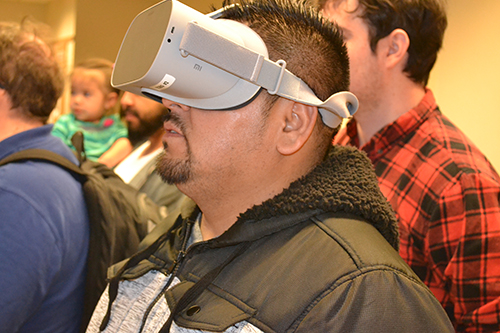
A dad at the exhibit enjoys a virtual reality tour of a carbon nanotube.
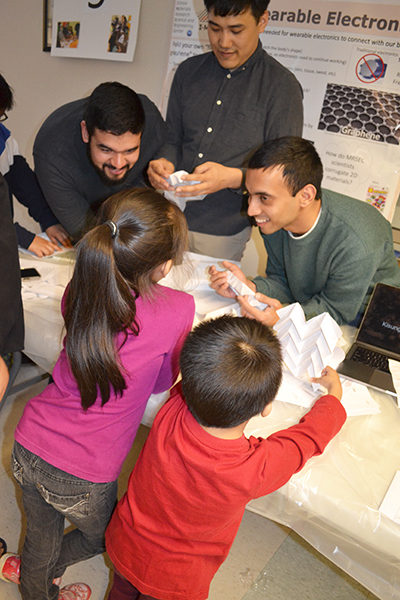
I-MRSEC grad students interact with young visitors learning about graphene at their table.
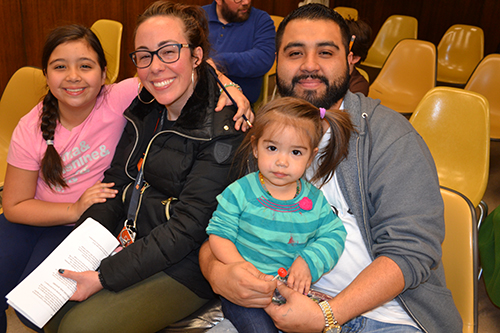
A family enjoys the closing activities of the Cena y Ciencias visit to MRL.
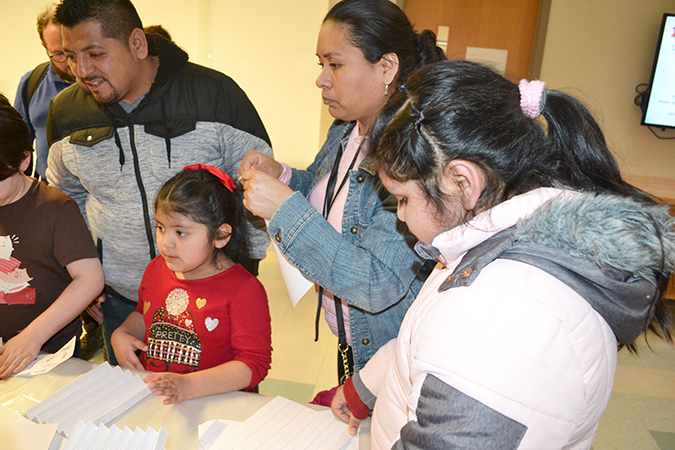
A family at the Cena y Ciencias visit to MRL learns about how graphene can be folded to use in flexible electronics applications.













.jpg)
















